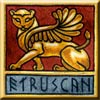
Turan is the Etruscan Goddess of love and beauty, much associated with the Greek Aphrodite. She was the patron Goddess of the city of Vulci, one of the main cities of Etruria, famous for its cemeteries and rich grave goods that now supply many a museum's Etruscan collections. Her name means "Lady" or "Mistress"; it is related to such Etruscan words as turannuve, "lovable, venerable", tur "give" or "dedicate", turan, "given" and turza "offer", which bring together the ideas of love and worship, implying that that which is lovable is also worthy of worship, and that love and the sacred go together. Venus of the Romans shares a similar idea in Her name, for it is related to the word venerate. Turan is depicted on a great deal of Etruscan art: on mirror-backs and terracotta panels, on vases and sculpture. Often She shares the iconography and narrative details of Aphrodite, whom the Etruscans knew from contact with Greek settlers in south and central Italy; She can be shown with doves or a swan—which in Etruscan style is given a name, Tusna, meaning "fullness" or "lushness"—or with the Etruscan version of one of Her lovers such as Atuns (known as Attis or Adonis in Greek lands) or taking part in the Judgement of Paris, the famous beauty-contest that ended up causing the Trojan War. In the Judgement of Paris scenes She is shown with Uni and Menrfa, and is easily identified by the fact that of the three Goddesses, Turan is the one hiking up Her skirt to show off Her trendy Etruscan boots and a good bit of leg. In a more purely Etruscan style, Turan is often shown with various attendants or handmaidens, including Lasa or the Lasae, Goddesses of fate. She presides over one scene on a mirror of the 4th century BCE that depicts the bride Malavisch being prepared for Her wedding. The attendants Zipu, Hinthial and Munthuch see to Malavisch's makeup and hair while Turan watches from the side; She holds a myrtle branch and wears rich jewelry while a dove perches on Her shoulder and a swan or goose stands behind Her. She seems to be overseeing the project, and is swathed in a concealing cloak; this contributes to an older or more "matronly" appearance than the other attending Goddesses, and perhaps this indicates an aspect of Turan as a Goddess of Love within marriage. On another mirror She embraces Hercle (Herakles) between Menrfa and a young male warrior. She is again wearing rich jewelry—an elaborate necklace, earrings, headband, and several bracelets—but this time Her drapery has slipped and She is mostly naked. On another, more elaborate, mirror She is again shown with Hercle, who holds an Erote or winged Cupid-figure; to their right are Tinia and Thalna, who form a couple, and it is reasonable to conclude that Turan and Hercle do as well. She holds a staff tipped with what looks to be a pomegranate; this could be indicative of Her aspect as a fertility Goddess. The pairing of Aphrodite with Herakles is not known in Greek legend, and no Etruscan tales of them have come down to us, but evidently They were lovers. She shared a temple with Menrfa and probably another Deity, likely Artimi (Artemis) or Aplu (Apollo) at the Etruscan city of Veii, the famous Temple Portonaccio, which had three cellae or chambers much like the later Roman temple of the Capitoline triad (Juno, Minerva, and Jupiter). She also had a cult center at Gravisca (the modern Torre di Corneto), the port town of Tarquinia in Latium where many Greeks came to trade, and where a large sanctuary dedicated to Turan was found with the remains of many votive objects inscribed to Her. Two of the other buildings there were dedicated to Hera and Demeter, as per the Greek influence. Again, Turan is one of the more than a few Etruscan Goddesses who seems to have survived into Tuscan folklore. Called Turanna, She is a spirit or faery of beauty and happiness, who helps lovers and those in love. She is also called Tiphanati. |
|
|



